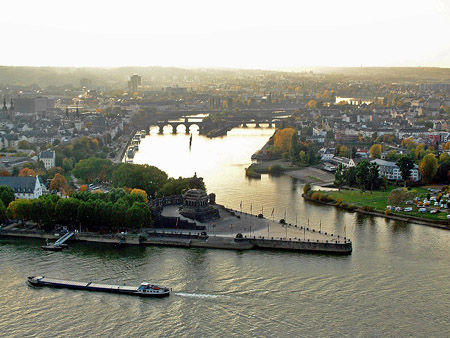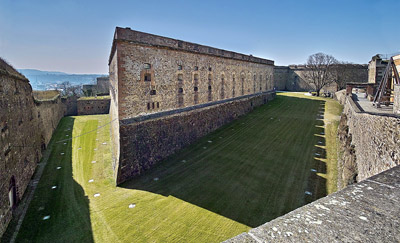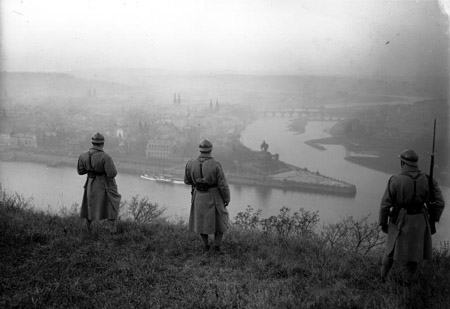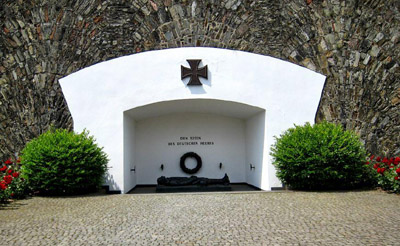 |
Festung Ehrenbreitstein
Ehrenbreitstein, Germany
|
|
 |
Constructed: 1817 - 1828
Used by: Prussia, Germany,
France, USA
Conflict in which it participated: Allied Occupation after WWI
|
The Deutsches Eck, or German Corner, is a headland at the German city of Koblenz, where the Rhein and Mosel rivers meet. These are two major rivers: The Mosel flows through most of eastern France, the Rhein through Germany's heartland.
Even back before there was a German heartland to protect, this confluence was seen as a strategic spot. The earliest fortifications at the Deutsches Eck have been dated to around 1000 BC. A person by the name of Ehrenbert first built a castle at this location around 1000 AD.
|
 |
|
|
It was at this time that Holy Roman Emperor Henry II (972-1024) gave the city to the Archbishop of Trier. Future archbishops of Trier clung to Koblenz until the end of the 18th century, for a time installing the Holy Tunic (the seamless robe of Jesus) at Ehrenbreitstein's castle, seeing it as a safe, defensible place at which to keep an ancient garment that may or may not have been worn by somebody important.
|
 The Deutsches Eck, as seen from Festung Ehrenbreitstein. Standing today at the Eck is a replica of an equestrian statue of German Emperor Wilhelm I (1797-1888), the original of which was damaged during the Second World War by American artillery. Next to the statue are sections of the Berlin Wall, representing German unity. The Deutsches Eck, as seen from Festung Ehrenbreitstein. Standing today at the Eck is a replica of an equestrian statue of German Emperor Wilhelm I (1797-1888), the original of which was damaged during the Second World War by American artillery. Next to the statue are sections of the Berlin Wall, representing German unity. |
 |
Towards the end of the 18th century, the archbishop made the castle at Ehrenbreitstein a sumptuous palace. French nobles, displaced by the revolutionary goings-on in their native land, met there to talk about, one assumes, those ridiculous revolutionary goings-on. Those nobles must have said nice things about Koblenz to their relatives still in France, because in 1794 the revolutionary army of the First French Republic conquered the city. In 1801 they made it the capital of a new French départment (sort of like a state or province), called Rhin-et-Moselle. On June 14, 1800, the French defeated the Austrian army at the Battle of Marengo, near the town (and starfort) of Alessandria, Italy. |
|
The Treaty of Lunéville (1801), signed betwixt the French Republic and Holy Roman Emperor Francis II (1768-1835) as a result of the crushing Austrian defeat, kept the French on the left bank of the Rhine at Koblenz. This left the castle at Ehrenbreitstein in German hands. The locals disassembled most of the castle, reasoning that there was no way they'd leave a ready-made castle for the French to reoccupy the instant they felt like defying the treaty, which was bound to happen eventually.
|
Pleasingly for everyone in the world except perhaps France, Napoleon (1769-1821) was finally defeated for good in 1815, bringing French domination of Europe to an end. The Congress of Vienna, held from September 1814 to June 1815 in the interest of redrawing the map of Europe, gave the Rheinland to Prussia.
Viewing the defense of the transportation hub of Koblenz as the highest priority, Prussia began work on Festung Ehrenbreitstein as soon as possible. The Festung was the main defensive point of what would become known as Fortress Koblenz.
|
 |
The Festung of our current interest, with the remains of the earlier castle visible just down the hill, in the bottom left corner of this shot. Click on it, it's huge. |
|
The obvious river transportation, plus railways and roads with bridges all crisscrossed at Koblenz, and France had already shown a willingness and ability to swoop down and capture the city. Fortress Koblenz consisted of a series of forts on hilltops to the west of the city, a line of fortifications defending the city to the south, and Festung Ehrenbreitstein, perched in a dominating fashion across the Rhein to the east. For a time, Fortress Koblenz was the second-largest fortification system in Europe, after the British system at Gibraltar.
|

Festung Ehrenbreitstein's Land Bastion. A pointy starfort corner within a starfort? Be still, my heart. |
 |
Even as the finishing touches were being put on Fortress Koblenz, such fortifications were already being seen as outdated and useless against the rapidly advancing art of European artillery. The system was kept operational, however, with Festung Ehrenbreitstein being brought up to its full strength of 1600 men and 80 cannon on a few occasions of perceived threat.
The Festung was decommissioned in 1890, and Fortress Koblenz was demolished: The city needed to expand beyond the boundaries set by its southern fortifications. |
|
Such events as the Franco-Prussian War (1871) and resulting Unification of Germany had also made France into much less of a threat to the Rheinland...but by this point France really wasn't much of a threat to anybody who could stand up and hold a rifle.
|
Festung Ehrenbreitstein didn't play a part in the First World War (1914-1918), but was occupied by the US Army from 1918 to 1923 as part of the postwar Occupation of the Rheinland. The Festung was designated to be destroyed as part of Germany's disarmament plan, but the commander of US forces in Germany, Brigadier General Henry Tureman Allen (1859-1930), recognized the fort as an important historical structure and prevented its destruction. The Order of the Starfort, Second Class has been posthumously awarded to General Allen for his starfort-related wisdom.
|
 |
 French troops, occupying Germany for what just may have been an unnecessarily lengthy period, overlook the Deutsches Eck from Ehrenbreitstein in 1929. |
|
Most of Allen's responsibilities while stationed at Festung Ehrenbreitstein, from whence he oversaw the American Zone of the Occupation, involved checking French ambitions in the area. Once US forces left the Rheinland on January 24, 1923, French troops gleefully moved into the Festung. Where they would remain until 1930, destroying the German economy and virtually guaranteeing another, even cooler war. Way to go, France.
|

The dead of the German army: A tomb of the unknowns at Festung Ehrenbreitstein. |
 |
During that inevitable Second World War (1939-1945), various important German archives and artifacts were kept at Festung Ehrenbreitstein. Three anti-aircraft guns were installed at the fort. Koblenz was badly damaged by Allied bombing during the war, as was just about every German city (this is the reason that, sadly, there are so few remaining German starforts today), but the Festung was relatively unharmed.
The same American unit that had occupied Festung Ehrenbreitstein after the First World War returned to the fort, even going so far as to raise the same US flag they had flown there last time.
|
|
Just to make sure everybody got the irony of the situation, the Festung was handed back over to French troops again shortly thereafter...but this time they left relatively swiftly, in 1947. Festung Ehrenbreitstein served as the seat of government for the Rheinland-Palatinate, one of the Federal Republic of Germany's 16 states.
Today, Festung Ehrenbreitstein operates a youth hostel, museum, restaurant and archive.
I feel I should note that I sailed past Festung Ehrenbreitstein in 1979, on a Rhine river cruise. Surely this fortification would have been pointed out to me, but I couldn't have cared less at the time (being thirteen and not caring about much of anything other than drawing and chocolate). The only specific memory of this cruise that I've retained is how unbearably spicy the "pepper steak" was that I was served for lunch. Can I blame France for that too? Sure I can.
|
|
|
|
|
|
 |




